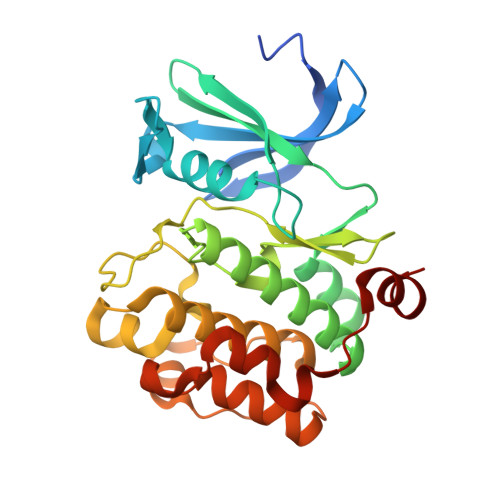Discovery of ( R)-8-(6-Methyl-4-oxo-1,4,5,6-tetrahydropyrrolo[3,4- b]pyrrol-2-yl)-3-(1-methylcyclopropyl)-2-((1-methylcyclopropyl)amino)quinazolin-4(3 H)-one, a Potent and Selective Pim-1/2 Kinase Inhibitor for Hematological Malignancies.
Wang, H.L., Andrews, K.L., Booker, S.K., Canon, J., Cee, V.J., Chavez Jr., F., Chen, Y., Eastwood, H., Guerrero, N., Herberich, B., Hickman, D., Lanman, B.A., Laszlo 3rd., J., Lee, M.R., Lipford, J.R., Mattson, B., Mohr, C., Nguyen, Y., Norman, M.H., Pettus, L.H., Powers, D., Reed, A.B., Rex, K., Sastri, C., Tamayo, N., Wang, P., Winston, J.T., Wu, B., Wu, Q., Wu, T., Wurz, R.P., Xu, Y., Zhou, Y., Tasker, A.S.(2019) J Med Chem 62: 1523-1540
- PubMed: 30624936
- DOI: https://doi.org/10.1021/acs.jmedchem.8b01733
- Primary Citation of Related Structures:
6MT0 - PubMed Abstract:
Pim kinases are a family of constitutively active serine/threonine kinases that are partially redundant and regulate multiple pathways important for cell growth and survival. In human disease, high expression of the three Pim isoforms has been implicated in the progression of hematopoietic and solid tumor cancers, which suggests that Pim kinase inhibitors could provide patients with therapeutic benefit. Herein, we describe the structure-guided optimization of a series of quinazolinone-pyrrolodihydropyrrolone analogs leading to the identification of potent pan-Pim inhibitor 28 with improved potency, solubility, and drug-like properties. Compound 28 demonstrated on-target Pim activity in an in vivo pharmacodynamic assay with significant inhibition of BAD phosphorylation in KMS-12-BM multiple myeloma tumors for 16 h postdose. In a 2-week mouse xenograft model, daily dosing of compound 28 resulted in 33% tumor regression at 100 mg/kg.
















